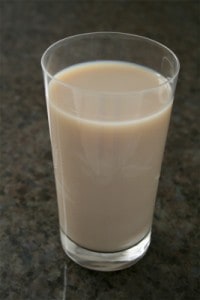Presenting Soylent, the food of the future, today. It’s the year 2014. People are still the same. They’ll do anything to do what they want…and what they want, apparently, is to optimize what they consume so they don’t have to waste time on silly things like buying groceries, cooking, eating and washing dishes.
That’s the premise behind Soylent, a protein powder invented by 25-year-old software engineer Rob Rhinehart. More than 10,000 crowd funders have already kicked in more than $1 million to see Soylent launch early this year in the U.S., with plans to expand internationally mid-year. Further, Rhinehart’s company Rosa Labs received $1.5 million in venture-capital funding last October.
What’s in Soylent?
The brand name is a bizarre reference to Soylent Green, the 1973 sci-fi flick in which the secret ingredient of a plankton-based superfood turns out to be human remains. According to a story on New York Magazine‘s Grub Street though, Rhinehart chose the unappealing brand name on purpose, as a preemptive rebuttal to the negative reaction he knew the product would meet: “The name is a little self-deprecating,” he says. “I knew there would be all sorts of visceral reactions, and people were going to talk about it on this shallow level. The name feeds into this.” I think I can hear David Ogilvy turning in his grave.
Soylent powder is made from a highly processed blend of oat flour, tapioca maltodextrin, brown rice protein isolate, canola oil, fish oil, fibre (mostly from oats, but also from xanthan gum and gum acacia) and vitamins, minerals and other micronutrients listed here (scroll down to the post on 2013-12-12, as there are no separate post links). Rhinehart claims that Soylent contains “everything the human body needs.”
What does Soylent taste like?
Last fall, several people beta-tested Soylent. One tester said this on the Soylent blog:
“Flavor? Pleasantly oatey. Much has been written about the taste so I’ll leave it at that. More important is how it feels to drink Soylent – it feels nourishing, efficient and smart. Drinking a glass of Soylent gives me the same satisfaction as crossing out a challenging task on my to-do list or emailing a finished design to a client. That’s because Soylent does more than solve the problem of hunger. Soylent assures me that I solved the problem intelligently by providing my body with the right nutrients. Instead of wasting time walking to a sandwich shop down the street and spending more money for food of questionable nutritional value, I can have a glass of Soylent and feel confident I made a better choice.”
We’re all busier than ever before, but visiting a sandwich shop down the street to eat every day is an expensive alternative in terms of both money and time. Have we completely lost the ability to know how to shop for a week’s worth of groceries, cook and store food in batches and pack lunches?
I could see using Soylent as an occasional meal replacement to save time, but I have several issues with Soylent as a staple food for entire days or weeks at a time:
- There is only anecdotal evidence about how consuming Soylent as a staple food affects the body.
- A few sentences on the Soylent website about how deficiencies in each nutrient can lead to certain health conditions doesn’t tell me how Soylent meets daily recommended levels.
- There are many other meal replacement alternatives on the market, such as protein bars and shakes.
- Nutrition experts say that we should limit liquid calories consumed, yet Soylent takes the opposite approach. By design, Soylent addresses a need for speed, but when you eat too fast, your body’s satiety signals don’t have a chance to kick in soon enough to tell you to stop eating. Further, does drinking a Soylent beverage fill you up? If not, it would be easy to exceed a healthy caloric intake.
- Variety is the spice of life, but Soylent approach lacks diversity. I know I would get bored eating the same thing, 3 times a day for weeks and weeks, missing my favourite solid foods and their different savoury flavours. Sure, it’s possible to add fruit or change the flavour with add-ins, but that couldn’t possibly compare with the different tastes and textures in a regular diet of solid food. Besides, what happens to intestinal flora if you eliminate diet diversity?
Would you buy this food as a staple, as a meal replacement, or at all?
Final thought – Any bets on how long it will be until someone tries to crowdfund soma?


